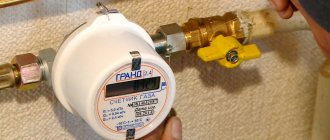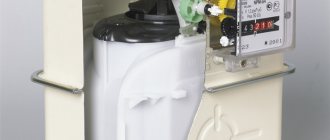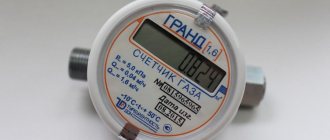Expert author of the article
Anton Bogdanov
Heat and gas supply and ventilation engineer. Prepares projects for gas supply to private houses.
A gas meter is a device installed between the main gas pipeline and appliances (gas stove, water heater, boiler). Twenty years ago, such a device in an apartment was rare, but now installing a gas meter is very important. A metering device can significantly reduce payment costs.
Is a gas meter required in an apartment?
According to paragraph 1 of Article 13 of Federal Law No. 261 “On energy saving and increasing energy efficiency and on amendments to certain legislative acts of the Russian Federation,” adopted on November 23, 2009, all devices that consume energy resources must be equipped with meters.
But there are a number of exceptions that allow you not to install measuring instruments without violating the law. If gas equipment is located in a building in emergency condition, subject to demolition or reconstruction, then it is not necessary to install a meter.
Also, a meter is not required if the volume of gas consumption does not exceed two cubic meters per hour. In simple terms, if only a gas stove is installed in the apartment, then installing a meter is not mandatory.
How to choose a gas meter
Despite the fact that in order to approve the project for installing a metering device, it is necessary to provide a data sheet for the flow meter, the choice of equipment should be made only after consultation with specialists. You should definitely inquire about the list of approved devices, since unlicensed devices will not be put into operation.
In order to select a flow meter, you should take into account its technical characteristics, especially paying attention to two criteria: throughput and type of device
The first criterion depends on the number and power of gas appliances installed in the house. For one slab, for example, a throughput of 1.6 m3/hour is sufficient. This parameter is indicated on the front panel and can be found out by looking at the value indicated after the letter “G”, that is, in this case you need a device marked G1.6.
The choice of meter depends on the throughput of gas appliances. For example, if for a gas stove it ranges from 0.015 to 1.2 m3/hour, then a meter with parameters of 1.6 m3/hour is optimal. In the event that several devices are installed and operated, then the minimum values of the least powerful and the maximum data of the highest consumption should be taken into account.
But you need to take into account that choosing an ideal flow meter for such a requirement is often an impossible task, so maximum values are taken into account. For example, if the minimum consumption of the stove is 0.015 m3/hour, and the maximum throughput of the boiler is 3.6 m3/hour, then you should purchase a meter marked G4
However, it is imperative to take into account the fact that the meter will be allowed to be installed if the deviation in the minimum value does not exceed 0.005 m3/hour. Otherwise, it may be necessary to install separate metering devices and, as a result, maintain two separate personal accounts
Main types of household gas meters
When choosing a meter, you should definitely take into account its type, which determines the principle of its operation, as well as the accuracy of the data obtained. Based on this criterion, individual consumers can choose devices:
- membrane These gas meters are distinguished by their low price, high reliability and completely reliable values. But they are very noisy devices;
- rotary devices. These devices are popular because of their compact size and fairly low price, but they have a short service life and are not highly accurate in the measurements obtained;
- ultrasonic devices. These meters are electronic devices and have high measurement accuracy. They are quite compact, silent and can be integrated into an overall system for remote data transfer.
Also, when choosing a gas meter, you should take into account its installation location, since these devices are right- and left-handed
It is also necessary to take into account what section of the pipe the installation will be carried out on: horizontal or vertical. You also need to decide on the location of the gas meter: in the house, in a warm, heated room, or on the street
In the latter case, you should buy a device with thermal correction, as evidenced by the letter “T” on the front panel of the device, indicated next to the throughput of the device.
Particular attention should be paid to the date of manufacture of the meter, since it is the starting point for determining the verification interval, which is individual and ranges from 3 to 15 years
Is it possible to install a gas meter yourself?
Despite the apparent simplicity of installing a gas meter in an apartment, working with gas is very dangerous, and only representatives of the gas service who have permission to do this type of work can do it.
Improper installation of gas equipment can become a source of many problems not only for the apartment owner, but also for the entire building. Therefore, the restriction on self-installation of gas is justified.
Even if a professional installed the meter, this work will be illegal without contacting Gorgaz. Therefore, you cannot do without a visit to the gas service. A meter installed without their knowledge will be considered unauthorized.
Documents for installing a gas meter
In accordance with changes in legislation, from 01/01/2019, owners of apartments and private houses are required to install individual gas consumption meters in their devices. The list of organizations that have the right to work with gas equipment is determined by Resolution of the Cabinet of Ministers No. 410 dated May 14, 2013. Clients can choose a contractor themselves if the terms of the current contract allow it.
When choosing a company, it is recommended to pay attention to the following aspects:
Low tariffs should be more alarming than encouraging. This may be evidence of low qualifications of workers or the use of low-quality materials.
The application is submitted to the company office and the following documents must be attached to it:
Copies of documents should be made in advance so as not to waste time on this in the office.
What documents are needed
Before installing a meter, you need to conclude an agreement with the city gas service.
Documents for installing a gas meter:
- Passport of the owner of the premises;
- Certificate of ownership;
- Passport for the meter;
- Passports for gas appliances;
- Plan of the gasified premises.
After collecting the documents, you need to contact Gorgaz, fill out an application for concluding an agreement there and hand it over to the employee along with all the documents. Your application will be registered and you will be contacted within 5 working days to confirm the date of the work.
Maintenance of gas meters
According to the maintenance agreement between the consumer and the gas distribution company, the latter is obliged to periodically monitor not only the metering device, but also the gas pipeline, as well as all devices connected to it.
The purpose of such control is to prevent emergency situations, therefore it includes:
- visual inspection of equipment;
- checking the tightness of connections and the operating condition of devices;
- testing for traction;
- carrying out minor repairs and maintenance of working units;
- detection of gas leaks, etc.
An important aspect of maintenance is monitoring the serviceability of devices. If problems are identified, the specialist makes a verdict to replace the equipment, even if its inspection period has not yet arrived. It should be noted that the cost of replacing a gas meter
, although it affects the consumer’s wallet, is completely justified, since not only the accuracy of accounting, but also the safety of people depends on the functioning of the device. It should also be noted that when the deadline for inter-verification occurs or when repairs are necessary, the consumer often prefers to replace the old meter with a new device. The reason for this decision is obvious and is related to the fact that dealing with these issues is often more expensive and time-consuming than simply installing a new gas meter.
You can order the installation of gas meters from ours by filling out an application on the website rosschet.ru.
Paid or free
The gas meter is an in-apartment equipment, which means that its installation is paid for by the apartment owner. The installation price may vary depending on the type of work and the region in which the work will be carried out.
Installation and replacement of the meter with welding work - about 6,000 rubles;
Installation of a meter without welding - about 2000 rubles;
Replacing a gas meter without welding costs about 1000 rubles.
Prices are given only for the service, without taking into account the price of the metering device itself and additional fastening elements.
But you shouldn’t immediately count out money for the installation of equipment, because the state provides benefits for certain groups of citizens when installing a gas meter. There are no discounts for pensioners who have a job and do not have other benefits.
You can count on benefits:
- Pensioners who do not have official work;
- Participants and veterans of the Second World War and other military operations;
- Disabled people of groups 1 and 2;
- Low-income citizens.
Gas meters are also installed free of charge in municipal apartments.
Benefits include both partial and full reimbursement of installation costs. You can clarify the amount of the benefit provided directly from the gas service. There are no benefits for purchasing the meter itself.
Sealing and checking
Installation of a gas meter involves its subsequent testing for tight connections and operability. First, air is forced out of the pipeline to prevent shock loads on the controller mechanisms. To do this, the valves at the inlet and outlet are opened, and then closed when the gas begins to escape. After this, already with the supply turned on, the device is checked for leaks. This is done using a brush and a soap solution applied to the joints. The absence of bubbles indicates that the work was done to a high standard.
The next step is sealing the meter. Without this operation, the device cannot be used legally. The master passes a wire or fishing line through the technological holes, inserts it into the seal, and then seals it. The seal has an identifier containing service information. It is strictly forbidden to remove the mark on your own; this will result in a large fine.
Finally, a report is drawn up indicating the readings, installation date and deadline for the next inspection.
Step 5. Registration, sealing, commissioning
After installation is completed, a gas service employee is required to check the functionality of the meter and the absence of gas leaks. Only after this can you sign a certificate for the work performed. This document will indicate the date of the work, the meter number, and the details of the workers who carried out the installation. The employee will also draw up an act on putting the meter into operation and a contract for servicing the meter.
But the fact that the gas meter is installed and ready for use does not mean that its readings can be transmitted to the gas service. An unsealed device is not considered legally installed and cannot be used to transmit readings.
The subscriber must submit a request to seal the meter. After submitting the application, Gorgaz employees will set a date for sealing the device. An employee will check that the meter is connected correctly, make sure it is working and put a seal. This completes the registration of the gas meter.
After installing the seal, you need to submit the commissioning certificate to the management company.
Employees of the management company will prepare an agreement for gas payment based on meter readings. Now you can pay for gas directly according to meter readings. Useful article? Rate and share with friends!
Installation procedure
The scheme of work is not complicated if the installation is carried out by specialists from the sales company. The instructions include the following sequence of actions:
- An application is submitted (a sample is on the official website) to the territorial branch of the gas distribution organization (utility service provider), through the “Single Window” service or the subscriber department. A complete list of documents is attached.
There is no single application form for the entire territory of the Russian Federation for installing a gas meter; this form is approved at the local level and may differ by region - A company employee contacts the owner or authorized person and agrees on the date and time of the visit.
- A specialist arrives at the appointed time and conducts a technical assessment of the installation site. The nuances are clarified and the appropriate meter model is determined.
- At the specified time, an installation team will arrive at the specified address to carry out the work. When placing the mechanism on the street, the installation of a protective box is carried out for a fee.
- The flow meter is registered and sealed. The device is registered, which is reflected in the next monthly receipt.
The contract for the provision of services is most often concluded on the spot, and the rules for depositing funds are explained to the user. If the installation is carried out by another licensed company, you must notify the supplying organization. A company representative must be present during installation. In such a situation, a separate application for sealing the meter is submitted.
Distance from the gas meter to various objects
The standards were determined for reasons of safety and functionality of the device. During installation, gas technicians comply with SP 42-101-2003 - General provisions for the design and construction of gas distribution systems made of metal and polyethylene pipes.
So, based on paragraph 6.49 of these rules, the gas meter can be installed outside areas with increased generation of moisture or heat. These include the stove and the space above it, the boiler, and the sink. At the same time, the minimum distance from the meter to the gas boiler and stove has clear boundaries.
In terms of the correctness of the readings, it does not matter whether a gas appliance is nearby or an electric one. If heat or moisture comes from it, then attention is also paid to temperature and humidity. The exact standards apply only to gas equipment.
For installation, choose only places with good natural ventilation, and forced ventilation in this case will only be a plus. Areas with stagnant air are definitely not suitable. The quality of the latter is determined by sensations.
Air conditions deteriorate in remote areas of the premises, areas behind partitions, and niches. Options located at a significant distance from windows and ventilation or with obstacles in their direction are not suitable.
During the work, installers use the information in the meter passports. Manufacturers indicate their recommendations and general requirements for gas meter models, minimum and maximum distances. Gas workers do not always rely on technical data, but act according to the situation.
If the manufacturer does not provide interval requirements at all, the installer must comply with the following universal parameters:
- The installation height standard is 160 cm. In the rules, this indicator is advisory and not mandatory.
- The margin to the wall must be maintained at least 3, and preferably 5 cm. The gap between the meter and the vertical surface is sometimes called corrosion and is provided in case of damage to the meter, at least 5 cm.
- The interval to the nearest gas-using device cannot be left less than 80 cm. We are talking about gas heating devices and the same household stoves. The category includes heat generators, boilers, instantaneous and capacitive water heaters.
Some types of equipment are separated by at least 1 m. For example, heating and cooking stoves and simple heating stoves, cooking boilers, restaurant stoves.
Distance is not measured from any point and in any direction. Take into account the radial interval from the gas meter. To put it scientifically, you need to install it in such a way that all three axes maintain a minimum distance from the nearest points on a meter that has not yet been installed to the same ones on the devices. Then there will definitely be no errors at intervals.
At least 5 cm is left between the side boundaries of the stove and the gas meter; three times the distance is made from the gas meter to the gas boiler or water heater. The placement level is selected no lower than 40 cm above the top edge of the slab and no closer than 15 cm from the top or bottom edge of the water heater.
Additional considerations when installing the meter
A gas leak detector is also installed at the same level as the meter. Before and after the meter, shut-off valve mechanisms, such as ball or some other, are mounted on the pipe. The taps allow you to quickly remove the gas meter for inspection or replacement.
Upon completion of the work, the joints and assemblies on the pipe with the meter are checked for leaks. It’s worth doing this right away so as not to call the technician again. Gas workers at distribution companies also check the equipment themselves, looking for leaks and leaks.
All connections and joints on the branch with the meter are then covered with soapy water. The installation of the gas meter is considered successful and the equipment is operational if no bubbles appear when gas is supplied.
Installing a gas meter outdoors
Installation from the street side is not an easy procedure, so this point will have to be discussed in advance. The answer will be given by the gas service, and it all depends on the specific situation and the feasibility of the task in principle. In general, there are no obstacles.
The meter housing will need protection against corrosion, otherwise other damage will occur to the device. The problem of protection from weather factors is solved with the help of a visor.
Before the gas enters the meter, you cannot do without a mesh barrier that prevents dirt from entering the meter. Sometimes the gas meter is placed in a cabinet on the facade and thus solves 2 problems at once.











